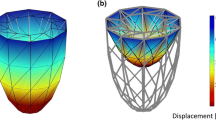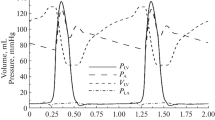Abstract
We coupled a continuum model of impulse propagation with a three-dimensional model of regional ventricular mechanics. Equations for action potential propagation, myofilament activation and active contraction were solved in an anatomically detailed finite element model of canine left and right ventricular geometry, muscle fiber architecture and Purkinje fiber network anatomy. Finite element equations for time-dependent excitation and recovery variables were assembled using a collocation method and solved using adaptive Runge–Kutta integration. Resting tissue mechanics were modeled as nonlinear, orthotropic and hyperelastic. A Windkessel model for arterial impedance was coupled to ventricular pressure and volume to compute hemodynamic boundary conditions during ejection. Ventricular volume constraints were imposed during the isovolumic phases. This model showed good agreement in the time course of regional systolic strains with experimental measurements during normal sinus rhythm and demonstrates the importance of the Purkinje fiber system in determining the mechanical activation sequence.
Similar content being viewed by others
Author information
Authors and Affiliations
Additional information
Received: 13 August 2001
Rights and permissions
About this article
Cite this article
Usyk, T., LeGrice, I. & McCulloch, A. Computational model of three-dimensional cardiac electromechanics. Comput Visual Sci 4, 249–257 (2002). https://doi.org/10.1007/s00791-002-0081-9
Published:
Issue Date:
DOI: https://doi.org/10.1007/s00791-002-0081-9




